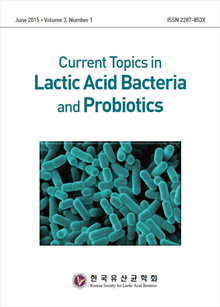간행물
Current Topic in Lactic Acid Bacteria and Probiotics KCI 등재후보 한국유산균·프로바이오틱스학회지

- 발행기관 한국유산균·프로바이오틱스학회
- 자료유형 학술지
- 간기 반년간
- ISSN 2287-853X (Print)
- 수록기간 2013 ~ 2024
- 주제분류 의약학 > 생리학 의약학 분류의 다른 간행물
- 십진분류KDC 573DDC 663
권호리스트/논문검색
Vol. 6. No. 2 (2020년 12월) 4건
Research Article
1.
2020.12
서비스 종료(열람 제한)
The status of probiotics is increasing worldwide and the range of application of probiotics is also being extended to the livestock industry. The use of probiotics in the swine industry aims to improve animal health and productivity by forming a healthy gut microbiota. Intensive pig breeding, a common breeding method in modern society, causes physiological stress in pigs, resulting in imbalance of the intestinal microbiota and dysfunction of the intestinal barrier. We conducted a scientific research on the properties of probiotics for multi-strain probiotics (MSP) and observed the economic benefits and efficiency of culturing MSP through a self-cultivation system in livestock. Initially, we observed alteration occurred by MSP application in the gut microbiota of pig. MSP were characterized to have resistance to digestive juices such as gastric acid and bile, followed by colonization in the target organ, the gastro-intestinal tract (GIT). In addition, MSP was also confirmed to have antibacterial ability against pathogenicity that most frequently infected in the swine industry and showed low resistance to antibiotics which means guaranteed stability when added to feed. The growth rate of probiotics in the optimized medium used in the self-cultivation system was suitable for efficiently and economically culturing and feeding pigs with high concentrations of probiotics, considering the ingredient price and the growth efficiency. We observed the significant alteration of gut microbiota of pig by application of MSP. Importantly, the MSP supplementation significantly increased the beneficial bacteria genus of Bifidobacterium that confer a health benefit to the host in pig GIT, whereas decreased the number of harmful bacteria including coliforms. In addition, MSP influenced on the uniformity of gut microbiota at both of sow and weaning pigs. Taken together, the application of MSP with high concentration of probiotics using self-cultivation system may critically improve the pig health by regulation intestinal microbiota.
2.
2020.12
서비스 종료(열람 제한)
Fermented foods of Korean temple are vegetable-based foods and their seasonings are limited to five pungent herbs. The aim of this study was to investigate cell-free supernatants (CFS) of lactic acid bacteria isolated from the fermented foods of Korean temples. Three selected CFS significantly inhibited the biofilm formation of Escherichia coli O157:H7 at 24 h, while one of the selected CFS markedly inhibited the biofilm formation at 72 h. However, only one CFS significantly attenuated the biofilm formation of Staphylococcus aureus at 24 h, but these CFS failed to inhibit the biofilm formation. Moreover, selected CFS effectively inhibited the growth of E. coli O157:H7, whereas the growth of S. aureus was not affected in the presence of CFS. These results suggest that CFS of lactic acid bacteria isolated from fermented foods of Korean temples shows antimicrobial activity agasint Gram-negative E. coli O157:H7, but not at Gramd-positive S. aureus .
3.
2020.12
서비스 종료(열람 제한)
Gamma-aminobutyric acid (GABA) is a functional component with physiological activity that helps to protect the liver from blood pressure reduction and alcohol damage, and is known to be widely distributed in various vegetables and fruits. In this study, a fermented rice syrup with enhanced GABA content was developed. The improved syrup was prepared by adding monosodium glutamate (MSG) to saccharified rice and using a complex of three types of lactic acid bacteria (Lactobacillus brevis, Lactobacillus plantarum, Leuconostoc mesenteroides ) with excellent GABA production ability. The physicochemical changes of the fermented rice syrup were measured, and the final pH of the product was 4.7 with a total water-soluble solid content of 22.1 °Brix. Of the dissolved solids, glucose (39.6 mg/mL) and maltose (12.7 mg/mL) were the main components, and it was confirmed that all MSG was converted to GABA. From the experiment, it was established that the rice syrup obtained from secondary fermentation of saccharified rice is suitable as a beverage base. The fermented saccharified rice syrup was differentiated from conventional rice fermented products which typically use yeast and acetic acid bacteria in the production process. The enhanced fermented rice syrup produced in this study was made using lactic acid bacteria in the fermentation and saccharified rice.
4.
2020.12
서비스 종료(열람 제한)
To develop Gamma-aminobutyric acid(GABA)-producing probiotics we isolated GABA-producing lactic acid bacteria from kimchi. 17 strains of GABA-producing lactic acid bacteria were isolated among 703 lactic acid bacteria originated from 21 kind of kimchi. Two strains, K991 and K998, were selected with highest GABA production ability. The results of 16S rRNA gene sequence analysis, K991 and K998 were identified as Lactococcus lactis, which showed 99.93% and 99.87% similarity, respectively. When the two strains were cultivated in MRS containing 5% MSG at 30°C, GABA began to be produced after 12 hours, reaching maximum production at 40 hours(13.20 mM and 13.35 mM, respectively). In contrast, GABA production was about three times lower when MSG was not added.

